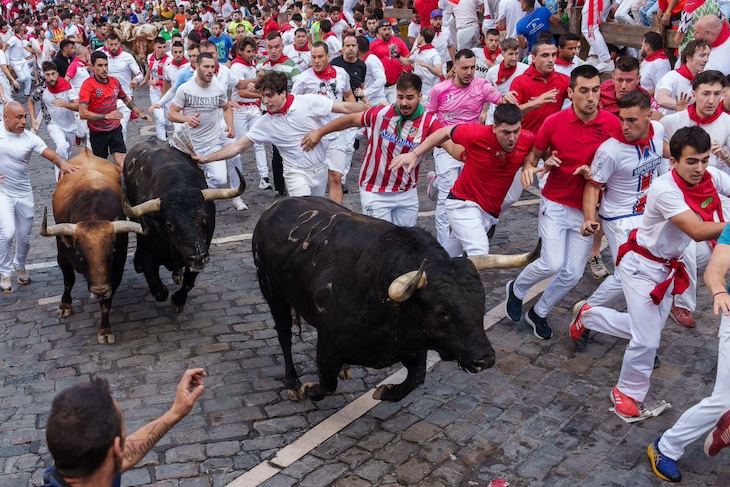A 57-year-old man was gored and killed during the bull running through the streets of Vall d’Uixo (population 31,000) in Spain last weekend. It was the third goring in three days in the town. In 2023 a total of eight people were killed by bulls in Spain during such events; the year before 23 died.
In 2023 more than a thousand people in the Valencia region required medical treatment after being trampled or gored
While in a formal bullfight it is the matador (literally ‘killer’) who almost invariably emerges victorious, in the streets the aggressive, astonishingly fast, half-ton bull sweeps all before it. The dangers were well illustrated a few years ago by dramatic footage on national television showing a bull swerving off a village street, crashing through the front door of a house and surprising a family in their dining room. Fortunately on that occasion no one was hurt but a great deal of furniture and crockery was smashed.
In the Valencia region alone there are nearly 9,000 taurine festivals each year. In 2023 in addition to the fatalities, more than a thousand people in the region required medical treatment after being trampled or gored. An animal rights spokesman commented: ‘Besides the cruelty to the animals that we always condemn, we shouldn’t overlook the fact that the medical treatment for these totally avoidable injuries is paid for out of the public purse – something that nobody mentions when the money that bullfighting supposedly generates is discussed.’
Many Spaniards regard bullfighting as a barbaric anachronism, the cruel and cowardly torturing of a dumb animal. It is already outlawed in some regions, and many would like to see it abolished everywhere. Spain’s left-wing national government wouldn’t dare go that far but earlier this year it did cancel the annual award for the national bullfighting prize worth £25,000.
The prize is likely to be restored when the right-wing parties, the Partido Popular and Vox, are next in power. Conservatives understand the importance of bull running as a traditional and central part of village fiestas in Spain. For many Spanish men it’s one of the high spots of their year – an eagerly anticipated opportunity to show courage and virility and to experience an irresistible adrenalin rush by running as close to the bulls as possible for as long as possible.
Immortalised in Hemingway’s The Sun Also Rises, the most famous bull runs of all are at Pamplona in the Fiestas de San Fermín in July. At eight o’clock every morning millions of Spaniards watch on television as the six bulls that are to be killed that afternoon chase the runners through the streets to the ring: there’s no commentary at all – just the sight and sound of the live action. A ‘clean’ run only takes a couple of minutes, but heart-stopping seconds go by if a bull has to be dragged off someone who’s been caught and gored. This year no one was killed but about 50 people needed hospital treatment.
For the hotel and tourism industry, the San Fermín fiesta is said to represent 25 per cent of the annual turnover. Nationwide, in figures that are disputed by animal-rights activists, the bullfighting industry is said to create employment for nearly 200,000 people. Its exotic appeal also attracts many tourists.
Apart from these economic benefits, bull running and bullfighting are also of great cultural significance. The Osborne bulls – huge black silhouetted images of bulls on hilltops across the country – have been declared part of the ‘cultural and artistic heritage of the people of Spain’. Celebrated in the art of Goya and Picasso and in the poetry of Federico García Lorca, bullfighting has long formed part of Spain’s perceived national identity. In his famous essay on duende (a state of heightened emotion and awareness of death) Lorca relates how with three magnificent passes Saint Teresa of Avila once stopped a charging bull in its tracks.
For a significant minority of Spaniards bullfighting is the so-called fiesta nacional, an ancient ritual and an art form. With deep roots and centuries of tradition, it is certainly hard to imagine Spain without bull running and bullfights: the ranches, the bullrings, the expertise, the traditional way of life and the public demand are not going to disappear overnight. Spain’s previous king, Juan Carlos I, once predicted that the day the European Union prohibited bullfighting would be the day that Spain left the EU.







Comments